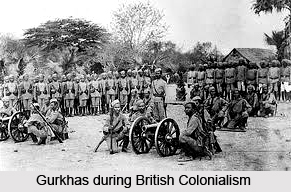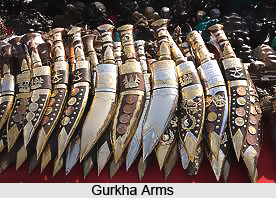The Gurkha War which is also called the Gorkha War or the Anglo-Nepalese War took place in 1814. Warren Hastings waged this war against the Gurkhas of Nepal as a result of border tensions and ambitious expansionism. The war ended with the signing of the Treaty of Sugauli in 1816.
 It was on too trivial a scale to teach the Company anything about these mysterious neighbours. In 1814, border raids and boundary disputes gradually led to a bigger quarrel, which for a time was `regarded as a mere affair with a troublesome Raja of the frontier`. Throughout-1814 and 1815, the Company had 40,000 men employed in the war; and in 1816 a force of 16,000, which included several European regiments as a spearhead, was needed for Ochterlony`s thrust into the country.
It was on too trivial a scale to teach the Company anything about these mysterious neighbours. In 1814, border raids and boundary disputes gradually led to a bigger quarrel, which for a time was `regarded as a mere affair with a troublesome Raja of the frontier`. Throughout-1814 and 1815, the Company had 40,000 men employed in the war; and in 1816 a force of 16,000, which included several European regiments as a spearhead, was needed for Ochterlony`s thrust into the country.
Like that other major disastrous war, the Afghan War of 1839, the Gurkha War was decided on by the Government, with little encouragement either from the financiers or the men closest to the field of action.
The war began, and for long continued, unsuccessfully. On 30 October 1814, General Gillespie tried to rush the fenced fort of Kalunga, or Nalapani, as he had formerly rushed Vellore and Fort Cornelis, and was shot through the heart. This outstanding defeat staggered public opinion and the war`s course quickly became such that the British needed all the consolation which divine poesy could afford them. At a second assault on the Kalunga stockades, 27 November, the troops hung back and let their officers die. The two attacks cost 260 and 480 casualties respectively, a total considerably more than the whole number of the garrison.
Three days after the second repulse, close siege that was combined with heavy bombardment of the confined space, resulted in Kalunga`s evacuation. The Gurkha commander and seventy men, the only unwounded section of his force of nearly 600 men, slipped unnoticed through our posts.
Three kingdoms of the Kathmandu valley - Kathmandu, Patan and Bhadgaon (presently known as Bhaktapur), had quarreled amongst themselves for centuries. They were too concerned with internal rivalry to pay attention to any potential danger from without. This detachment enabled Prithvi Narayan Shah, the king of Gorkha to conquer the valley for constructing the foundations for the modern Kingdom of Nepal. The traditional valley kings under threat from Gurkha expansion asked help to the British in 1769 but it resulted in an ill-equipped and ill-prepared expedition numbering 2,500 led by Captain Kinloch. This expedition led to a disaster. By providing the Gorkhas with firearms and filled them with suspicion, the incompetent British force caused some to underestimate their future opponents.
This conquest of the Kathmandu valley was only the beginning of an explosion of Gorkha power throughout the region. The Gorkha armies had infested all of eastern Nepal by 1773 and the Gurkha forces had also annexed some western portions of Sikkim by 1788. By 1790 the entire western region and the Kumaon region and its capital Almora had also succumbed to the Gurkhas. On the other hand the Chinese Emperor in Peking acted in response to the raids into Tibet. He sent a huge army in 1792 and expelled the Nepalese from Tibet to within 5km of their capital at Kathmandu. Acting regent Bahadur Shah, son to Prithvi Narayan, appealed to the British Governor-General of India, Francis Rawdon-Hastings and Lord Moira for help. Lord Moira sent Captain Kirkpatrick as mediator to avoid confrontation with the Chinese. But before his arrival the war with China had ended. The Nepalese were forced into signing a humiliating treaty. Their trading privileges in Tibet were withdrawn and were asked to pay tribute to Peking every 5 years.
 A previously planned attack on the Garhwal Kingdom was postponed by the Tibet affair. But Raja of Garhwal Pradyuman Shah had also been defeated by 1803. After his death in January 1804, all his land was annexed.
A previously planned attack on the Garhwal Kingdom was postponed by the Tibet affair. But Raja of Garhwal Pradyuman Shah had also been defeated by 1803. After his death in January 1804, all his land was annexed.
The British were also preparing themselves to expand their sphere of influence. The British East India Company acquired the lands of Nawab of Awadh and this brought the region of Gorakhpur into the close proximity of the raja of Palpa(the last remaining independent town within the Gorkha heartlands). Suspicion of the raja`s conspiracy with the British caused his imprisonment by the Gorkhas and then his ultimate assassination. The Nepalese Prime Minister from 1806 to 1837, Bhimsen Thapa, installed his own father as governor of Palpa and this led to serious border disputes between the two powers.
The rise of these disputes was the result of the absence of a fixed boundary that could separate the Gurkhas and the British. The Governor-General imposed a border commission on Nepal but it failed to solve the problem. The tension was increased by the Gurkha raids into the flatlands of the Tarai, a much prized strip of fertile ground that separates the Nepalese hill country from India. The fragile line of communication between Calcutta, now Kolkata, and the northwest were under threat was felt by the British. Since there was no clear border, confrontation between the powers was inevitable.
At the time of the expansion of the empire of Gurkhas into Sikkim in the east, Kumaon and Garhwal in the west and into the British sphere of influence in Oudh in the south, the British East India Company was also concentrating on consolidating its position in India from its main bases of Calcutta, Madras and Bombay. This expansion of the British had already been resisted in parts of India, climaxing in the Maratha Wars and in the Punjab as well. It was therefore imperative to the British that the Gorkha war was quickly and successfully concluded.
The first British campaign was an attack on two fronts and in the eastern front, Major-General Bennet Marley and Major-General John Sullivan Wood led their respective columns across the Tarai towards the heart of the valley of Kathmandu. Captain Latter led a small force in a primarily defensive role in further east on the Sikkim border.
Major-General Rollo Gillespie and Colonel David Ochterlony commanded the two columns in the western front and these columns were pitted against the cream of the Gorkha army under the command of Amar Singh Thapa. These four columns were composed mainly of Indian troops, though Ochterlony`s was the only column without a single British infantry battalion. The Commander-in-Chief of the British forces was Lord Moira.
The start of the campaign was not good for the British as the General Gillespie had been killed trying to take the weakly-defended fort at Kalanga at the Battle of Nalapani before a day the Governor-General officially declared war on 1 November 1814. Colonel Sebright Mawby managed to take Kalanga by cutting off its water supplies before Gillespie`s successor Major-General Gabriel Martindell took over command. After the arrival of Martindell, the British suffered further setbacks at the hands of Ranjur Singh Thapa, son to Amar Singh Thapa, at the Battle of Jaithak. After the failure of Martindell in the end, Wood and Marley did not feel it safe to face the enemy. Their attempt to attack their opponent proved to be timid. Now all the hopes of victory was depended on the abilities of Colonel Ochterlony`s force and he slowly and decisively pushed Amar Singh`s army higher and higher into the mountains until, in April 1815, the Gorkha general had been forced back into his main fort at Malaun.
The following Battle of Dionthal was important and in this battle Amar Singh`s most able lieutenant, Bhakti Thapa, failed to dislodge the British from the Dionthal ridge overlooking the Malaun fort. The fort held out for a while after the death of Bhakti Thapa in the action on 16 April. Amar Singh Thapa realised the severity of the situation after the arrival of the news of Almora`s fall to Colonel Jasper Nicolls` strong force of regular sepoys on 26 April. Threatened by the British guns, Amar Singh Thapa surrendered. During the campaign Ochterlony was promoted to major general.
After the successful campaign of Ochterlony, the Kathmandu durbar failed to ratify the peace agreement that was signed on 28 November 1815. This reticence to sign soon led to the second campaign and Ochterlony was placed in command of the 20,000 strong invasion force of Nepal by Lord Moira. When General Ochterlony was advancing towards Makwanpur, the king of Sikkim performed simultaneous operation that drove the Nepalese army from the east. Amar Singh Thapa remained inactive in this campaign as he had taken retirement. The Battle of Makwanpur on 28 February 1816 and the fall of the neighbouring fort of Hariharpur made the situation critical for Nepal. Nepalese were threatened by the British to ratify the treaty without any further delay. After these The Treaty of Sugauli was signed on 4 March 1816.
The aftermath of the war resulted in realization of the strength and potential of the Gorkha soldiers in British service. The British service employed about 5,000 men most of whom were not `real` Gorkhas but Kumaonis, Garhwalis and other Himalayan hill men. Eventually these groups were called by the term Gurkha and they became the backbone of British Indian forces.



















